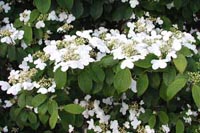Resource Library
Plant of the Week: Summer Snowflake
The University of Arkansas System Division of Agriculture does not promote, support or recommend plants featured in "Plant of the Week." Please consult your local Extension office for plants suitable for your region.
Plant of the Week
Summer Snowflake
Latin: Viburnum plicatum var. tomentosum

As gardeners, we tend to be greedy. We want plants that have it all: good looks, lots of flowers, easy to grow and freedom from pests.
To help achieve that goal, the Arkansas Green Industry and horticulturists at the University of Arkansas Cooperative Extension Service have teamed up to create the Arkansas Select program. Plants named as Arkansas Select winners are relatively new items that we think provide gardeners with the kind of positive gardening experience they are seeking.
One of the plants designated an Arkansas Select winner for 2004 is Summer Snowflake Viburnum, a selection of the doublefile viburnum known officially as Viburnum plicatum var. tomentosum. The doublefile viburnum is so named because it blooms in clusters along the horizontal stems, with a row of blossoms on each side of the stem, creating a double row.
This Japanese species is one of the most popular of the many viburnums in cultivation. In the typical cultivar, the plant is as broad as it is tall with the limbs arranged in horizontal layers. But in ‘Summer Snowflake,’ a selection released from the University of British Columbia Botanic Garden, the plant is decidedly tall and skinny. It can grow as tall as 15 feet but with a spread of only 6 feet.
Most consider viburnums to be "shrubs," but they are on the large end of the shrub range or the runtish end for trees. This plant is deciduous with leaves a bright, mid-green color with a pleated appearance. Fall color is a rusty red and quite handsome.
Summer Snowflake first blooms around the end of April or the first of May, about a week after dogwoods finish. The white flowers are individually about the size of a quarter, but borne in a flat head that is to four inches across. The blooms splayed on the horizontal branches give the plants a wedding-cake kind of look when they appear.
Other than the upright growth form, the other thing that sets Summer Snowflake apart from other viburnums is that it is a repeat bloomer. Admittedly, the first bloom of the season is much more showy than the ones to follow, but about once a month, additional blooms pop out here and there on the ends of new growth.
Gardeners favor viburnums because they have multiple seasons of interest; showy flowers, bright red berries and good fall color. Summer Snowflake has two of the three - usually it sets few berries. Part of the reason for its ability to continue flowering during the growing season is because it does not have a load of berries to support.
The upright growth form and repeat blooming habit makes Summer Snowflake an ideal plant for use near an entryway. It could be used near the entry to the home or beside the garden gate in the kind of location where you might use a Japanese maple or dogwood. In addition, the tall, narrow form of the shrub makes it ideal for an informal screen that would not have to be pruned.
Summer Snowflake, like most viburnums, grows best in sunny locations with good garden loam. But it is not overly picky about its growing conditions. It will grow and flower in semi-shade; areas too shady for bermudagrass to grow but where shade tolerant grasses would be expected to survive. It has good drought tolerance once established, but plants in droughty locations will have few repeat blooms. It does not seem bothered by insect or disease problems.
By: Gerald Klingaman, retired
Extension Horticulturist - Ornamentals
Extension News - May 21, 2004
The University of Arkansas System Division of Agriculture does not maintain lists of retail outlets where these plants can be purchased. Please check your local nursery or other retail outlets to ask about the availability of these plants for your growing area.